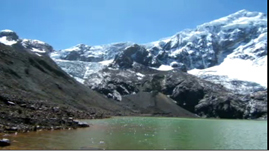Teachers' Domain - Digital Media for the Classroom and Professional Development
User: Preview

Source: ThinkTV
Water is a precious commodity in Peru. The populous areas west of the Andes are largely desert and rely on glacial meltwater as an important source of fresh water. But the Peruvian glaciers, high in the Andes, are in rapid retreat. In this video produced by ThinkTV, join scientists from the Byrd Polar Research Center who specialize in glaciers and water quality as they monitor the steadily shrinking glaciers and the impact on local populations.
In Peru, as in many countries around the world, glaciers are losing mass—they are getting shorter and thinner. Glacial melt is often measured in loss of extent or area, as changes in thickness are not as easily measured. Due to global climate change, glaciers in the Andes Mountains have lost at least 22% of their area since 1970. The rate of loss has increased in recent years.
The loss of glacial mass can have a direct impact on local populations because nearly 69% of the world’s fresh water is stored in glaciers, which cover about 10% of the world’s landmass. In countries such as Peru, which are in tropical latitudes but have high mountain glaciers, much of the local water supply can come from glacier meltwater.
Peruvians on the dry western side of the Andes depend on glacial meltwater for mining, industry, growing their food, and personal uses such as drinking water and washing clothes. Further downstream, along the coast, is Lima, the world's second largest desert city. The eight million residents of Lima depend upon glacier meltwater for drinking water and hydroelectric power.
As Peru's glaciers retreat, or lose mass, they will have an impact on both the quantity and quality of fresh water available. Water quality can be affected first, as shrinking glaciers can expose rocks containing metals and sulfur, which are potentially toxic if released into the water supply. The diminishing quantity of water is also a concern, in an area that already has an inadequate supply of water. Estimates are that between one and two million people in Lima are already without sufficient clean drinking water.
At their present rate of shrinkage, the ice fields of Peru could disappear within 20 years, due to climate change. Scientists will continue to monitor them closely, as water shortages and water quality issues become an increasingly important issue in many areas of the world.
Here are suggested ways to engage students with this video and with activities related to this topic.
 Loading Standards
Loading Standards